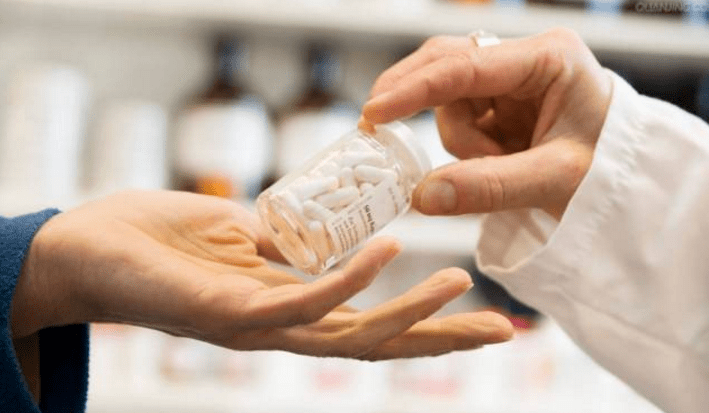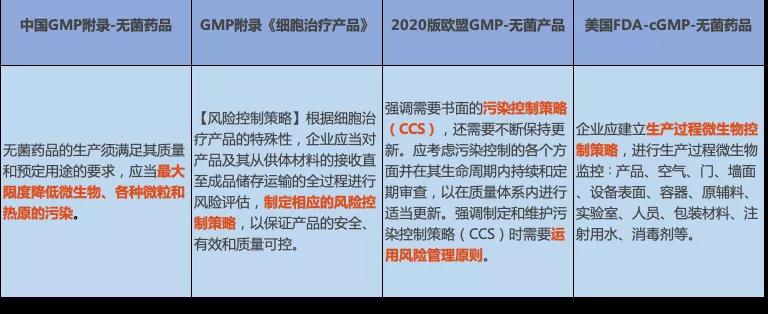扫一扫 添加小助手
服务热线
13818320332
扫一扫 关注我们
 药品的生产制备、储运、使用的全生命周期过程,因微生物污染而导致药物变质的情况可能导致用药安全问题,对药品生产企业来说(尤其是无菌药品),防污染是无菌药品生产中必须确保的要素之一,因此防止及消除污染对于无菌药品生产质量保障来说至关重要,应建立有效的污染控制策略(CCS)并进行维护。本文分享了药品污染控制策略(CCS)几个关注的问题。
药品的生产制备、储运、使用的全生命周期过程,因微生物污染而导致药物变质的情况可能导致用药安全问题,对药品生产企业来说(尤其是无菌药品),防污染是无菌药品生产中必须确保的要素之一,因此防止及消除污染对于无菌药品生产质量保障来说至关重要,应建立有效的污染控制策略(CCS)并进行维护。本文分享了药品污染控制策略(CCS)几个关注的问题。
污染控制策略(CCS)为何物?
我们可以从2020年02月20日发布的EU GMP附录《Manufacture of Sterile Products(无菌药品生产)》征求意见稿可以找到具体的定义:
Contamination Control Strategy (CCS) - A planned set of controls for microorganisms, pyrogens and particulates, derived from current product and process understanding that assures process performance and product quality. The controls can include parameters and attributes related to active substanc, excipient and drug product materials and components, facility and equipment operating conditions, in-process controls, finished product specification, and the associated methods and frequency of monitoring and control.
污染控制策略(CCS) - 来自于现行产品和工艺理解,为确保工艺性能和产品质量,所计划的一套对微生物、热源和微粒的控制。这些控制包括与原料药、辅料、药品的物料和组分、设施和设备操作条件、过程控制、成品质量标准相关的参数和属性,以及相关的监测和控制的方法及频次。
当前国内外污染控制策略(CCS)
法规对比分析
相比美国FDA和欧盟EU的GMP附录,我国目前GMP法规未明确强调要求药品生产企业制定书面的污染控制策略(CCS),但在2019年11月28日,国家药品监督管理局食品药品审核查验中心官网重磅发布《GMP附录-细胞治疗产品》(征求意见稿),首次明确要求企业制定相应的风险控制策略,弥补了我国对药品污染控制策略(CCS)法规层面的空白,国内外污染控制策略(CCS)法规梳理总结对比如下表,从而更加直观地比较中美欧药品GMP关乎于CCS的监管异同:

污染控制策略(CCS)
文件如何编写
根据对于污染控制策略(CCS)的理解,CCS在我们的文件体系中,CCS可以是一个或多个文件,而且内容非常庞大,建议以产品为主线去编写自己企业的CCS,没有一次就写到最好的CCS文件,先按这个思路去思考、做出来,然后在实施的过程中,再根据认知的提升、对风险的思考的提升、对积累的数据的分析,不断地更新文件,达到更好。
你得到的不是一个更好的CCS文件,而是一个更好、又更好的质量保证状态。污染控制策略(CCS)的污染控制策略应考虑的要素包含(包括但不局限于):
i. Design of both the plant and processes.(厂房和工艺的设计)
ii. Premises and equipment.(厂房设施和设备)
iv. Personnel.(人员)
v. Utilities.(公用系统)
vi. Raw material controls – including in-process controls.(起始物料的控制-包含中间控制)
vii. Product containers and closures.(产品包装)
viii. Vendor approval – such as key component suppliers, sterilization of components and single use systems (SUS), and services.(供应商的批准-例如关键组分的供应商、部件的灭菌及一次性使用系统(SUS)和服务。)
ix. For outsourced services, such as sterilization, sufficient evidence should be provided to the contract giver to ensure the process is operating correctly.(对于委托外部的服务,例如灭菌,应将充分的证据提供给合同的委托方,以确保工艺的正确操作。)
x. Process risk assessment.(工艺风险评估)
xi. Process validation.(工艺验证)
xii. Preventative maintenance–maintaining equipment, utilities and premises (planned and unplanned maintenance) to a standard that will not add significant risk of contamination.(预防性维护保养-设备,公用系统及设施的维护保养(计划性及非计划性维护保养)符合标准,不会加大显著的污染风险。)
xiii. Cleaning and disinfection.(清洁和消毒)
xiv. Monitoring systems-including an assessment of the feasibility of the introduction of scientifically sound, modern methods that optimize the detection of environmental contamination.(监测系统-包括对引入检测方法的可行性评估,方法科学合理,现代化,能够优化环境污染的检测。)
xv. Prevention-trending, investigation, corrective and preventive actions (CAPA), root cause determination and the need for more comprehensive investigational tools.(预防措施-趋势分析、调查、纠正和预防措施(CAPA)、根本原因的确定以及需求更全面的调查工具。)
xvi. Continuous improvement based on information derived from the above.(基于来自上述衍生信息的持续改进。)
参考文献
EU GMP 附录1《Manufacture of Sterile Products(无菌药品生产)》
文章来源:GMP行业药文
本网站刊载的所有内容,包括文字、图片、音频、视频、软件等,如非标注为“原创”,则相关版权归原作者所有,如原作者不愿意在本网站刊登相关内容,请及时通知本站,我们将第一时间予以删除。